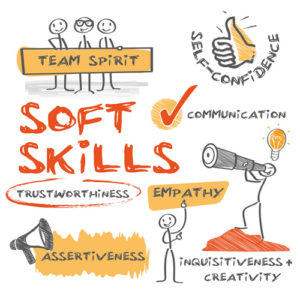With the rise of automation, organizations worldwide have made soft skills like communication, collaboration, and critical thinking a top priority. To work successfully alongside machines, recent grads and the current workforce must rely on what makes them uniquely human.
According to the ManpowerGroup’s 2016-2017 Talent Shortage Survey, “the most important skill you can nurture is learnability” to stay employable for the long-term. Ironically, the term “learnability” often refers to how easy a software product or interface is to use. However, in the case of employability, it means professionals must become lifelong learners to remain usable themselves.
There is a glaring need for soft skills in the workforce, but a significant gap remains between what skills recent grads think they have and what organizations believe they’re proficient in. Two recent surveys—one that polled students and one that gathered the employer perspective—revealed some startling discrepancies.
- Oral communication skills: More than 65 percent of college students feel very confident they’re prepared to use oral communication skills in the workplace, while less than 30 percent of employers feel the same.
- Critical-thinking skills: Nearly 70 percent of students are confident in their critical-thinking skills, while just 26 percent of employers have the same confidence in their abilities.
- Collaboration skills: Nearly 80 percent of students believe they can work in teams successfully, while less than 40 percent of employers share that sentiment.
The soft-skill-development issue
These discrepancies are alarming, but what causes them?
The soft skills gap exists because these competencies are nearly impossible to assess and improve at scale using traditional methods. Not only do instructors often lack the time and resources to work with students one-on-one to develop these skills, but paper-based assessments can’t accurately measure every soft skill.
The increase in online course offerings adds another layer to the problem. Because instructors, students, and their peers often have less face-to-face contact in distance learning environments, it’s difficult to facilitate the necessary interactions to build soft skills. As a result, many learners don’t properly develop these core competencies prior to graduation.
As organizations and institutions continue to search for ways to close the soft skills gap, video assessment has emerged as a viable solution. Video-assessment platforms enable students to have more face time with their peers and the instructor, while also giving everyone the luxury to interact on their own time, from any device.
Here are five ways video assessment helps close the soft skills gap:
1. Experiential exercises
Correctly identifying car parts on a diagram doesn’t mean you know how to build one any more than picking the right answer from a list of choices means you know how to handle a workplace conflict. There are certain variables at play that individuals can only learn through practice. The best video assessment solutions offer experiential exercises where students encounter real-life scenarios and figure out how to master them. Because they’re practicing this through video, students are continuously honing their ability to communicate effectively and articulate their knowledge in the workplace.
2. Personalized feedback
Summative assessments certainly have value, but research shows that students improve faster when they receive personalized feedback. Giving individuals specific examples of their strengths and weaknesses helps them identify what works and what doesn’t, allowing them to apply that knowledge to future assignments. Many video assessment solutions have feedback capabilities where instructors and peers can deliver personalized comments to students through time-stamped text or video. The ability to pinpoint the exact moment a student didn’t communicate well or misunderstood the context is a critical component of skill building.
3. Evidence of job readiness
Instead of relying solely on paper-based assessments to determine whether recent graduates have the necessary skills to succeed, video-assessment platforms can provide direct evidence of job readiness. To see if students possess specific competencies, instructors can watch a recording of an experiential exercise to see what skills they can demonstrate in a relevant setting. Completing these exercises successfully also gives graduates something to show prospective employers, along with the confidence to succeed in their chosen field.
4. Peer review
Students build valuable skills like communication and critical thinking from peer review, but this process is often difficult to facilitate. The best video-assessment platforms make peer review possible at scale because they host all the videos and feedback features within the same platform. For example, once a learner submits his or her assignment, he or she can be immediately prompted to review another student’s video and provide feedback.
5. Self-assessment
Countless studies have shown how self-assessment promotes lifelong learning, the foundational element of ManpowerGroup’s reference to learnability. This is mainly because understanding how to reflect on one’s own work improves an individual’s ability to think critically and provide feedback to others. Video-assessment platforms enable self-assessment by giving learners the opportunity to reflect on their video prior to submission and re-record it if necessary. This helps foster a mindset of continuous improvement that students often carry on into their career after graduation.
- Survey: More students want to go to graduate school - April 24, 2024
- Educause, AWS launch generative AI readiness assessment tool for higher ed - April 23, 2024
- A bungled FAFSA rollout threatens students’ college ambitions - April 19, 2024

